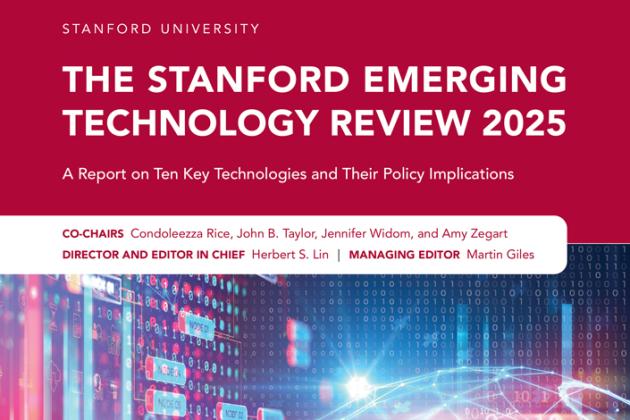Dr. Drew Endy is a Science Fellow and Senior Fellow (by courtesy) at the Hoover Institution and heads the Hoover Technology Policy Accelerator’s Bio-Strategies and Leadership Initiative. He is also the Martin Family University Faculty Fellow in Undergraduate Education (Bioengineering) at Stanford University.
Drew, there’s been talk for some time now about a “bio-belt” in the United States. What does that term mean?
In America we have a tremendous capacity to leverage biology to grow stuff, starting with agriculture. But there’s much more we can do in terms of manufacturing things in partnership with living systems. I went to school in Bethlehem, Pennsylvania, when Bethlehem Steel was shutting down a big plant. I recently went back and looked at the old site. What I saw was lots of flat land with good rail and energy infrastructure right next to a reliable supply of fresh water from the Lehigh River. That’s a great combination of resources that can be put to work in biomanufacturing.
Biology is increasingly being unlocked as a general-purpose technology, which means that anything we can encode in DNA can be manufactured through processes starting with liquid- and solid-state fermentation. For instance, there’s a company in South Carolina called MycoWorks that’s just opened a $100 million factory using mushrooms to grow a leather-like material that goes into cars, luggage, or shoes. The key input to this factory is sawdust from the state’s lumber and furniture sectors. You could situate biofactories anywhere across a US bio-belt in, say, Pennsylvania, Ohio, Nebraska, and many other states, because we’ve got a diversity of feedstocks, from corn stover to sugar and sawdust, as well as diverse sources of power available across the country.
The South Carolina factory is producing a leather-like material. What other things can biomanufacturing supply?
Today about 5 percent of the US’s economic output is built with biotechnology, divided up into three slices. The first of these is agricultural production. The second is manufacturing of industrial molecules that go into polymers to make sustainable textiles. And the third is medicine. By expanding the bio-belt, we could make more and better foods, textiles, and medicines increasingly close to where they are needed. That would reduce our reliance on centralized stockpiles. We could have distributed, resilient public health and biodefense capacities, as well as the ability to biomanufacture other things our society relies on. A nation-wide bio-belt can promote manufacturing resilience in the same way that the Eisenhower interstate system created resilient logistics and the internet created resilient communications.
We already have distributed manufacturing capability for producing biofuels. Does the bio-belt idea overlap with this?
I think it’s completely complementary with biofuels. We’re not talking about competing with them; what we’re talking about is leveraging biotechnology to boost our ability to manufacture more valuable products across many different categories. For instance, if you’re making biofuels and you have some extra substrate where you are, perhaps that could be used to power a biofactory that makes essential medicines. We’re talking about a forward-facing opportunity that can satisfy many different sectors of the economy.
This sounds like an exciting opportunity, but how do we pay for it? You’ve talked about bio-bonds. What’s the idea behind them?
We need biomanufacturing capacity at a scale that’s big enough to matter, by which I mean big enough to impact positively those who need these solutions or products, whether that’s another sector of the economy or patients. We also need to make sure that the handoff from the technology innovators to the entrepreneurial manufacturers is well supported. And that’s where the idea of bio-bonds is incredibly important.
The goal is for the private sector to contribute capital and, most importantly, expertise in decision making around when and how to commit that capital. This is where the idea of bio-bonds comes in. We’re just bringing this idea into the open, and so I’m only sketching out here how this idea might work. Everyone will have to collaborate to fine-tune how this operates in practice.
The involvement of the financial sector is crucial. Professional money managers value opportunities to offer investments that pay modest returns that are tax-free at the state level. There are all sorts of financial instruments that already exist to meet this demand. So states could help by promoting tax-free bio-bonds to support entrepreneurs looking to build biomanufacturing plants. The states that do this could stipulate the feedstocks they care about, the types of jobs they want to create, and the types of industries they want to connect to in the bioeconomy. Companies who meet these criteria could then apply to float a tax-free bond in a particular state to help finance their investment in a new factory. There would need to be a partnership with the financial sector, which would issue, underwrite, and manage the bonds, as well as facilitate trading in them
What kind of scale and timeline are we talking here?
Let’s get some numbers on the table. Let’s say that around fifteen years from now we would like America to have one thousand state-of-the art biomanufacturing facilities covering all sectors of the bioeconomy. If each of these factories costs $100 million, then we’re looking at a $100 billion of new investment. I don’t think it’s responsible or realistic to go to the Congress and say, “Hey, can you give us another $100 billion of precious public treasure?”
So we need a better way to create a biomanufacturing equivalent of the interstate network. Historically in the United States, we’ve been world leaders at frontline innovation in biotechnology, but we haven’t scaled our capacity to do biomanufacturing. And now we’re at risk of seeing the same playbook that happened with solar and batteries for electric cars—where the US pioneered the technologies only to see China or others produce them at scale – repeating with biomanufacturing. A significant bio-bond initiative could help prevent this from happening.
When it comes to a timeline for rolling out a bio-bonds initiative, I think we’re talking about a gradual ramping up. Today, there are still many examples of biomanufacturing ideas out there that don’t make economic sense. So, I think we need to stage this very carefully. If we were piloting this in 2025, I think we should be looking at a couple of billion dollars. As we learn more about how to make the approach work, we’d scale to tens of billions.
But if the opportunities are so great, wouldn’t private capital want to pursue them anyway? Why do we need bio-bonds?
We need to incentivize private capital to come off the sidelines more quickly. There’s already a shortage of domestic precision fermentation capacity, which uses microorganisms to produce proteins and other biomolecules in the same way that brewers feed sugar to yeast to make beer. This shortage means the most innovative and successful bio-entrepreneurs are pushed to manufacture outside the United States. They basically have no choice. Then there’s China, which has taken an all-of-nation approach to emerging technologies and especially to biomanufacturing. If you want to understand the current state-of-the art in precision fermentation, one nation you need to visit is across the Pacific Ocean. Our best and brightest innovators are increasingly courted by Chinese manufacturers with incredible access to modern factories supplied with low-cost energy and feedstocks.
Again, America needs to decide whether we’ll watch a rerun of offshoring photovoltaic solar cells, electric car batteries and other areas. And, as I mentioned in passing before, there’s an important national security dimension here: a distributed national infrastructure for biomanufacturing is essential for biodefense; a domestic bio-belt would help everyone in all fifty states have resilient access to medical diagnostics, treatments, and vaccines, if and whenever needed. But bio-bonds shouldn’t be limited to medicines. The potential to manufacture many kinds of products will help make a wide range of supply chains more resilient.
Let’s say we get to the high tens of billions raised through bio-bonds, Drew. What kind of downstream issues are we going to need to think about?
We’ll need to be thinking from the beginning about many things, such as the relationship between employers and unions. What are some of the lessons we’ve learned in the United States about how to create harmonious and productive relationships between workers and factory owners? If bio-bonds for the bio-belt work, what we’re talking about is the development of a significant percentage of the nation’s manufacturing capacity for the future. How we architect the system will have tremendous impacts on livelihoods, incomes, and economic growth. So, from a cultural, political, and economic sense, bio-bonds are going to be very impactful. That’s what’s so exciting here. We have the possibility to build a twenty-first century economy for America that’s compatible with our founding principles of life, liberty, and the pursuit of happiness.











